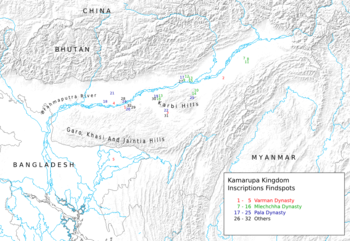Kamarupa inscriptions
The Kamarupa inscriptions are a number of 5th-century to early 13th-century rock, copper plate and clay seal inscriptions associated with the rulers and their subordinates of the Kamarupa region. The common language of these inscriptions is Sanskrit. The earliest of these inscriptions, the Umachal and Nagajari-Khanikargaon rock inscriptions, belong to the 5th century and written in a script which was nearly identical to the eastern variety of the Gupta script.[2] There is a steady evolution in the script over the centuries, and last of the scripts, for example the Kanai-boroxiboa inscription using a proto-Assamese script.[3] The script in this period is called the Kamarupi script, which continues development as the Medieval Assamese script from the 13th to the 19th century and emerges as the modern Assamese script.


Though the language is Sanskrit, there appear systematic Prakriticisms that indicate an underlying colloquial Indo-Aryan language, called Kamarupi Prakrit.[4]
List of inscriptions
The list below is from (Lahiri 1991, pp. 26-27), and the numbers in the list correspond to the ones given in the find spot map.
| Name | Kind | Ruler | Date | Find spot | Find Year | |
|---|---|---|---|---|---|---|
| 1 | Umachal | Rock | Surendravarman | 5th century | Nilachal Hills, Guwahati | |
| 2 | Nagajari-Khanikargaon | Rock | - | 5th century | Khanikargaon, Golaghat | |
| 3 | Barganga | Rock | Bhutivarman | 6th century | Barganga river, Nagaon | |
| 4 | Dubi | Copper plate | Bhaskarvarman | 7th century | Dubi village, Kamrup | |
| 5 | Nidhanpur | Copper plate | Bhaskarvarman | 7th century | Nidhanpur village, Sylhet, Bangladesh | |
| 6 | Nalanda | Clay seals | Bhaskarvarman | 7th century | Nalanda, site-1, monastery 1 | |
| 7 | Sankara Narayana | Image | Sri Jivara | 8th century | Deopani, Golaghat | |
| 8 | Hari-Hara | Image | Diglekhavarman | 8th century | Deopani, Golaghat | |
| 9 | Tezpur | Rock | Harjaravarman | 830 CE | Tezpur | |
| 10 | Hayunthal | Copper plate | Harjaravarman | 9th century | Hayunthal, Karbi Hills | |
| 11 | Deopani Vishnu | Image | - | 9th century | Deopani, Golaghat | |
| 12 | Tezpur | Copper plate | Vanamalavarmadeva | 9th century | Tezpur | |
| 13a | Parbatiya | Copper plate | Vanamalavarmadeva | 9th century | Parbatiya village, Tezpur | |
| 13b | Kaliabor | Copper plate | Vanamalavarmadeva | 9th century | Dighali village, Nagaon | |
| 14 | Uttarbarbil | Copper plate | Balavarman III | 9th century | Uttarbarbil village, Karbi Hills | |
| 15 | Ulubari | Copper plate | Balavarman III | 9th century | Ulubari village, Darrang | |
| 16 | Nagaon | Copper plate | Balavarman III | 9th century | Sutargaon village, Nagaon | |
| 17 | Bargaon | Copper plate | Ratnapala | 1035 CE | Naharhabi village, Tezpur | |
| 18 | Suwalkuci | Copper plate | Ratnapala | 1036 CE | Suwalkuci village, Kamrup | |
| 19 | Coratbari | Copper plate | Ratnapala | 11th century | Coratbari village, Nagaon | |
| 20 | Gauhati | Copper plate | Indrapala | 1058 | Barpanara village, Kamrup | |
| 21 | Guwakuci | Copper plate | Indrapala | 1071 | Guwakuci village, Nalbari | |
| 22 | Gachtal | Copper plate | Gopalavarman | 1080 | Gachtal village, Nagaon | |
| 23 | Subhankarapataka | Copper plate | Dharmapala | 12th century | (not known) | |
| 24 | Pushpabhadra | Copper plate | Dharmapala | 12th century | Pushpabhadra river bed, North Guwahati | |
| 25 | Khonamukh | Copper plate | Dharmapala | 12th century | Khonamukh village, Nagaon | |
| 26 | Kamauli | Copper plate | Vaidyadeva | 1142 | Kamauli, Uttar Pradesh | |
| 27 | Assam | Copper plate | Vallabhadeva | 1185 | Tezpur | |
| 28 | Kanai-Boroxiboa | Rock | (not known) | 1206 | North Guwahati | |
| 29 | Ambari | Stone | Samudrapala | 12th-13th centuries | Guwahati | |
| 30 | Gachtal | Pillar | (not known) | 12th-13th centuries | Gachtal, Nagaon | |
| 31 | Surya | Image | (not known) | 9th century | Kaki, Nagaon | |
| 32 | Gauhati | Copper bell | Srikumara | 8th century | Guwahati | |
Notes
- (Lahiri 1991:26–28)
- (Lahiri 1991, pp. 58-59)
- (Lahiri 1991, pp. 57-58)
- "... (it shows) that in Ancient Assam there were three languages viz. (1) Sanskrit as the official language and the language of the learned few, (2) Non-Aryan tribal languages of the Austric and Tibeto-Burman families, and (3) a local variety of Prakrit (ie a MIA) wherefrom, in course of time, the modern Assamese language as a MIL, emerged." (Sharma 1978, pp. 0.24-0.28)
References
- Bora, Mahendra (1981). The Evolution of Assamese Script. Jorhat, Assam: Assam Sahitya Sabha.
- Lahiri, Nayanjot (1991). Pre-Ahom Assam: Studies in the Inscriptions of Assam between the Fifth and the Thirteenth Centuries AD. Delhi: Munshiram Manoharlal Publishers Pvt Ltd.
- Sharma, Mukunda Madhava (1978). Inscriptions of Ancient Assam. Guwahati, Assam: Gauhati University.